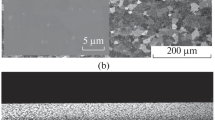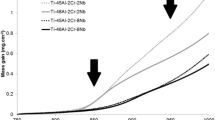Abstract
Thermodynamic calculations are performed to estimate isothermal sections of Ti-Al-O, Ti-Si-O, and Ni-Al-O phase diagrams. Very small aluminum levels (<10−10 at. %) are needed to stabilize alumina on Ni-Al alloys. However, much higher aluminum (≳50%) and silicon (≳40%) levels are needed to stabilize alumina and silica on Ti-Al and Ti-Si alloys, respectively. These calculations suggest that the mechanism of formation of the protective oxide films on titanium-based alloys is radically different from that on nickel-based alloys. The aluminum levels needed to form a continuous film of alumina on nickel-based alloys are dominated by kinetic factors. On the other hand, thermodynamic factors appear to dominate the alloy compositions needed to form protective films of alumina and silica on titanium-based alloys. Further work is needed to evaluate any possible role of kinetic factors.
Similar content being viewed by others
References
P. Kofstad,High Temperature Corrosion (Elsevier Applied Science, London, 1988).
T. B. Massalski, J. L. Murray, L. H. Bennet, H. Baker, and L. Kacprzak,Binary Alloy Phase Diagrams (American Society for Metals, Metals Park, Ohio, 1986).
M. W. Chase, Jr., C. A. Davies, J. R. Downey, Jr., D. J. Frurip, R. A. McDonald, and A. N. Syverud, JANAF thermochemical tables (Third Ed.),J. Phys. Chem. Ref. Data 14, (Suppl. 1) (1985).
V. V. Samokhval, P. A. Poleshchuk, and A. A. Vecher,Russian J. Phys. Chem. 45, 1174–1175 (1971).
I. Barin,Thermochemical Data of Pure Substances (VCH Publishers, New York, 1989).
L. Kaufman and H. Nesor, Coupled phase diagrams and thermochemical data for transition metal binary systems-V,CALPHAD, 2, 325–348 (1978).
L. Kaufman, Coupled phase diagrams and thermochemical data for transition metal binary systems-VI,CALPHAD, 3, 45–76 (1979).
V. V. Glazova,Doklady Akad. Nauk SSSR, 164, 567–570 (1965).
F. S. Pettit,Trans. Met. Soc. AIME 239, 1296 (1967).
G. H. Meier, D. Appalonia, R. A. Perkins, and K. T. Chiang, inOxidation of High Temperature Intermetallics, T. Grobstein and J. Doychak, eds. (TMS Mineral, Metals and Materials Society, Warrendale, Pennsylvania, 1988), pp. 185–193.
R. A. Perkins, K. T. Chiang, and G. H. Meier,Scripta Metall. 21, 1505–1510 (1987).
D. W. McKee, to be presented at the Symposium on High Temperature Intermetallic Alloys, MRS meeting, Boston, Massachusetts, Nov. 26–Dec. 1, 1990.
N. S. Choudhury, H. C. Graham, and J. W. Hinze, Properties of high temperature alloys,The Electrochem. Soc. 77–1, 668 (1977).
C. J. Rosa,Oxid. Met. 17, 359 (1982).
R. Hultgren, P. D. Desai, D. T. Hawkins, M. Gleiser, and K. K. Kelley,Selected Values of the Thermodynamic Properties of Binary Alloys (American Society for Metals, Metals Park, Ohio, 1973), p. 194.
Author information
Authors and Affiliations
Rights and permissions
About this article
Cite this article
Luthra, K.L. Stability of protective oxide films on Ti-base alloys. Oxid Met 36, 475–490 (1991). https://doi.org/10.1007/BF01151593
Received:
Revised:
Issue Date:
DOI: https://doi.org/10.1007/BF01151593




